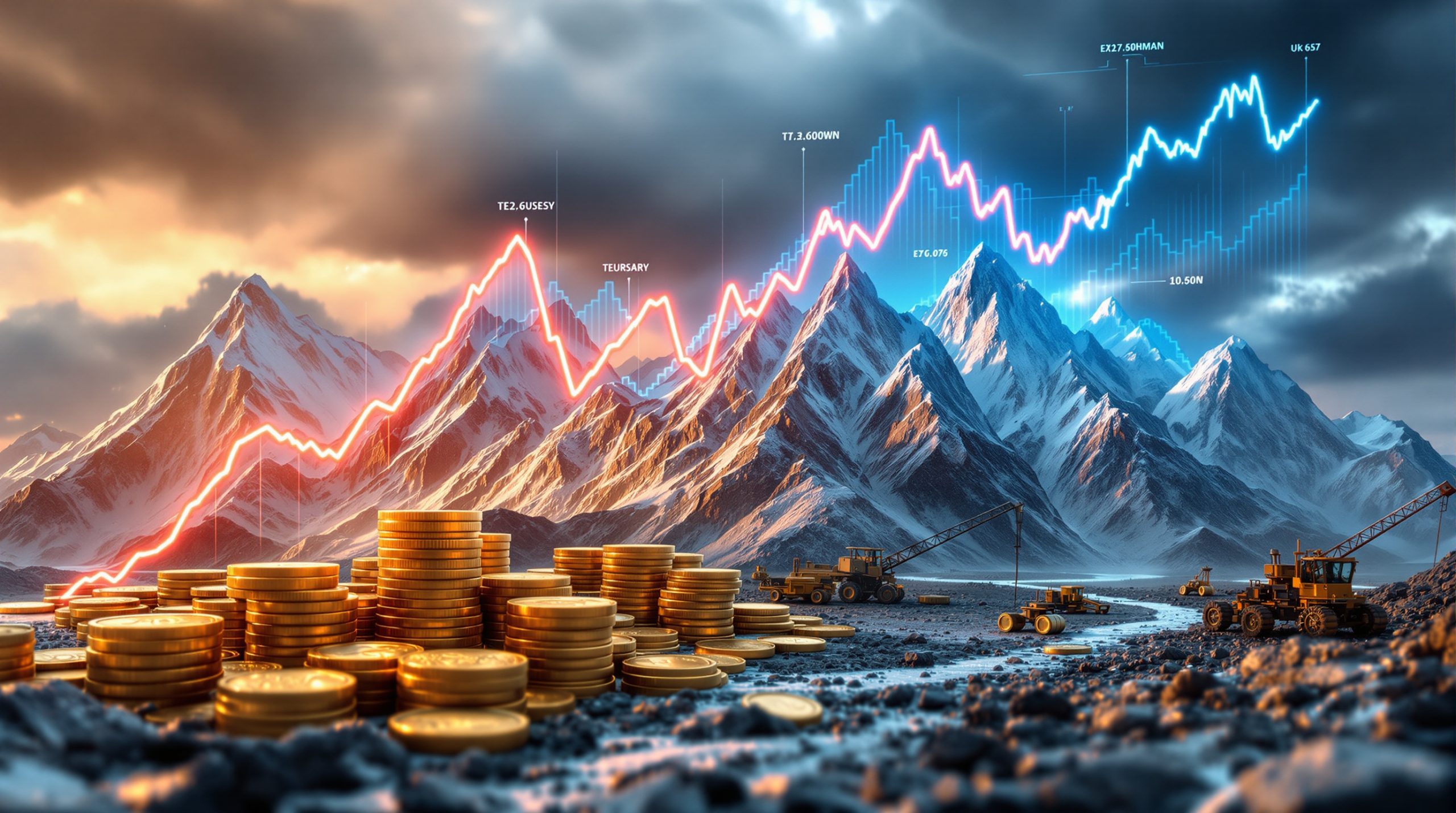How Has the Global Materials Industry Performed in 2024-2025?
The global materials industry has demonstrated remarkable resilience despite economic headwinds in 2024-2025. While the metals and mining segment experienced a revenue contraction of approximately 6% to $3 trillion, overall profitability has remained impressively robust at around $1.3 trillion across the broader materials sector. The metals and mining sector alone contributed approximately $700 billion to this total, highlighting the industry's fundamental strength even during challenging market conditions.
This performance is particularly noteworthy considering the cyclical reset in commodity prices that affected thermal coal, steel, and battery materials. Despite these challenges, 2024 still ranks among the four most profitable years for the sector in the past two decades, underscoring the industry's adaptability and resilience.
Key Performance Metrics for 2024-2025
The materials industry has experienced significant shifts in profit pools, with traditional powerhouses like coal and steel seeing decreases while gold, copper, and aluminium have gained ground. This redistribution reflects broader changes in global economic priorities and technological needs.
| Sector | Revenue Change | Profit Pool | Notable Trends |
|---|---|---|---|
| Metals & Mining | -6% to $3T | $700B | Shift to gold copper aluminium |
| Overall Materials | Contraction | $1.3T | Among top 4 profitable years in two decades |
| Thermal Coal | Price reset | Declining share | Record global production of 8B tonnes |
| Battery Materials | Price reset | Stabilizing | Slower EV adoption affecting demand |
Record global thermal coal production reached 8 billion tonnes in 2024, even as the industry continues to navigate through price volatility and changing demand patterns. Meanwhile, battery materials have begun to stabilize following a period of significant price fluctuation, partly due to the moderation in electric vehicle adoption rates in key markets.
What Major Global Shifts Are Reshaping the Materials Landscape?
The materials industry is navigating several transformative global shifts that are fundamentally altering market dynamics and strategic priorities. These changes are creating both new risks and opportunities for industry participants across the value chain.
Rising Resource Nationalism and Protectionism
Geopolitical tensions have significantly intensified focus on critical minerals, resulting in a wave of new tariffs, export restrictions, and investment incentives that are reshaping global supply chains. These measures predominantly target commodities with concentrated supply chains that are deemed strategically important for national security or economic development.
African nations have been particularly active in implementing export barriers on ores and concentrates, aiming to capture more value through domestic processing and create local jobs. This strategy reflects a broader push to move beyond the traditional role of raw material suppliers toward higher-value activities in the global materials value chain.
Meanwhile, resource-importing countries are establishing strategic stockpiles and creating financial incentives to develop local supply chains, reducing vulnerability to potential disruptions. These initiatives include faster permitting processes, improved access to financing, and direct government investment in critical minerals projects.
Emerging Demand Drivers: AI and Defense
Technological advancements, particularly in artificial intelligence, are creating new demand patterns for certain materials. AI in mining operations requires significant quantities of specialized materials, creating new growth markets that partially offset slowdowns in other sectors.
McKinsey projects that copper demand related to data centers could increase by approximately 3% by 2030, partially offsetting slower growth in traditional sectors. This trend highlights the evolving nature of materials demand as technological innovation creates new applications and use cases.
Defense spending is also emerging as a significant driver of materials demand, with military modernization programs requiring substantial inputs of specialty metals and minerals. Increased geopolitical tensions have accelerated defense budgets globally, creating sustained demand for materials used in advanced weapons systems, military vehicles, and communication infrastructure.
Productivity Renaissance Through Technology
After years of declining productivity in the mining sector, a notable rebound is underway, supported by technological innovations and improved management practices. Traditional AI systems are advancing as computing costs decline, allowing for more sophisticated data integration across mining operations.
Key technological enablers of this productivity renaissance include:
- Generative AI applications for maintenance optimization and operational decision support
- Advanced automation systems for remote operations, reducing labor costs and improving safety
- Electrification initiatives reducing operational costs and environmental footprint
- Next-generation operational systems enhancing efficiency and resource utilization
These technologies are helping companies offset cost inflation while improving safety outcomes and environmental performance. For example, traditional AI systems can reduce fuel consumption in mining fleets by up to 10% through integrated management of fleet operations, asset tracking, and data on road quality and tire pressure.
Why Are Gold, Copper, and Aluminium Gaining Strategic Importance?
The materials industry is experiencing a significant shift in profit pools away from traditional powerhouses like coal and steel toward gold, copper, and aluminium. This transformation reflects changing global priorities and the critical role these metals play in the energy transition and digital economy.
Gold: Resilience Amid Economic Uncertainty
Gold continues to demonstrate its value as both a safe-haven asset and an industrial metal. In an environment characterized by geopolitical tensions and shifting monetary policies, gold has maintained strong investor interest. This demand has supported robust pricing and profitability for gold producers.
The metal's dual role in financial markets and industrial applications provides a unique value proposition that few other commodities can match. While industrial demand remains relatively stable, investment demand fluctuates based on broader economic conditions, creating a natural hedge that supports long-term price stability. For a comprehensive gold highs analysis, investors should consider both macroeconomic factors and supply constraints.
Copper: The Essential Metal for Electrification
Copper has emerged as perhaps the most critical metal for global decarbonization efforts. Its unmatched electrical conductivity makes it essential for numerous growth sectors, including:
- Renewable energy infrastructure (solar, wind, and transmission)
- Electric vehicle manufacturing and charging infrastructure
- Energy storage systems
- Data center expansion and digital infrastructure
- Grid modernization projects
This combination of use cases has positioned copper at the intersection of multiple global megatrends, creating sustained demand growth potential. However, the industry faces significant challenges in bringing new supply online, as many proposed copper projects require prices well above current market levels to achieve economic viability. Recent copper price insights suggest continued strength as supply constraints persist.
Aluminium: Lightweight Champion for Sustainability
Aluminium's combination of light weight, corrosion resistance, and recyclability has positioned it as a key material for sustainable development. Its versatility across multiple applications creates diverse demand drivers:
- Transportation lightweighting initiatives to improve fuel efficiency
- Renewable energy infrastructure, particularly solar mounting systems
- Building efficiency improvements through better insulation and reflective surfaces
- Packaging sustainability requirements, particularly as an alternative to plastics
China's elimination of export rebates for aluminium has further tightened global supply, supporting price stability despite economic headwinds in some regions. This policy change reflects China's broader shift toward higher-value production and increased focus on domestic resource security.
What Supply-Demand Dynamics Are Shaping Materials Markets?
The materials sector is experiencing complex supply-demand dynamics that vary significantly across commodities. While overall capacity increases have generally kept pace with expectations, structural constraints persist in several key markets.
Supply Concentration and Diversification Efforts
Supply remains highly concentrated for several critical commodities, particularly rare earth elements. However, McKinsey has observed signs of large-scale diversification, with changes in the top three supplying countries for more than half of the world's largest commodities by revenue.
This diversification trend offers promising signs for future supply security. Importantly, up to 60% of global reserves lie outside the top three producers, including:
- 62% of global copper reserves
- 44% of rare earth elements
- 36% of lithium
This distribution suggests significant potential for future reserve development beyond currently announced projects, particularly as technological innovations improve the economic viability of lower-grade deposits and previously inaccessible resources.
Shifting Supply-Demand Balances
Forecast supply-demand balances for nickel and cobalt shifted in 2024 from projected shortages to possible surpluses. This change reflects both increased production capacity and moderating demand growth, particularly from the electric vehicle sector.
Similar trends are emerging under high-case supply scenarios for other commodities, including:
- Uranium
- Rare earth elements
- Manganese
The moderation of electric vehicle adoption has reduced demand for rare earth elements, while China's construction slowdown has weakened steel consumption, leading to lower demand for metallurgical coal and manganese. These shifts highlight the dynamic nature of materials markets and the importance of flexibility in supply planning.
Investment Requirements and Economic Viability
McKinsey highlights that incentive prices for copper, nickel, and lithium remain above current market levels needed to meet projected 2035 demand, leaving many new projects economically unviable under current conditions. This gap creates potential supply constraints that could support higher prices in the medium term.
Closing the global supply-demand gap completely could require trillions of dollars in investment, massive new power capacity, and continued innovation in extraction and processing technologies. These challenges are particularly acute for copper, where declining ore grades and increasing project complexity have driven up development costs significantly.
How Is Decarbonization Affecting the Materials Sector?
The materials industry's decarbonization trajectory has become more complex, with progress slowing in certain regions and commodities while accelerating in others. This divergence reflects both economic realities and changing policy landscapes across major markets.
Slowing Momentum in Key Sectors
Battery electric vehicle sales in Europe and the United States have flattened or decelerated as a share of total car sales compared with previous years. This trend has implications for battery materials demand and associated supply chains, potentially moderating growth expectations for lithium, cobalt, and nickel.
In the European steel industry, decarbonization efforts have faced significant headwinds. Nearly a third of announced decarbonization projects have been put on hold or canceled due to economic challenges and competitive pressures. As of late 2024, approximately 40% of all direct reduced iron projects in the EU – representing 14 million tonnes of yearly capacity – had been suspended or canceled, while nearly 30% of low-carbon steelmaking projects have been delayed or paused.
Declining Green Premiums
McKinsey's latest survey of materials buyers and sellers found a declining willingness among customers to pay premiums for low-carbon or "green" materials. The share of respondents unwilling to pay any premium rose to about 50% for steel and copper, compared with about 35% and 40%, respectively, in 2024.
Aluminium showed more stability in customer willingness to pay for sustainability attributes, with about half of customers unwilling to pay extra. This variation highlights the importance of customer segmentation when marketing sustainable materials, as targeting the right customer segments with a win-win value proposition can improve the economics of decarbonization business cases.
Projected Emissions Trajectory
Despite these challenges, McKinsey estimates that total metals and mining emissions could decline by approximately 6% over the next decade. By 2035, overall demand growth is expected to add about 620 million tonnes of CO₂-equivalent annually, mainly due to the expansion of battery material production.
This increase could be offset by a combination of factors:
- Grid decarbonization (contributing ~40% of the reduction)
- Efficiency improvements (contributing ~30%)
- Greater recycling (contributing ~20%)
These combined efforts are expected to lead to an overall net emissions decrease, even as production volumes continue to grow across most commodity categories. Furthermore, the implementation of energy transition strategies will be crucial for sustainable industry development.
What Opportunities Exist for Industry Players?
Despite challenges, the materials sector offers significant opportunities for companies that can navigate the changing landscape effectively. Strategic positioning, operational excellence, and technological innovation will be key differentiators in capturing value in this evolving environment.
Growth Through Geographic and Product Diversification
Companies can pursue growth by expanding into new geographies and critical materials, capitalizing on government incentives for domestic supply development. These opportunities include entering emerging mining jurisdictions, developing previously overlooked deposits, and moving into adjacent parts of the value chain.
Opportunities also exist in recycling, scrap processing, and high-growth niche sectors such as digital infrastructure and defense. These segments often offer more stable demand patterns and potentially higher margins than traditional bulk commodities, providing diversification benefits for established players.
Productivity Enhancement Through Technology
Accelerating productivity through technologies such as generative AI and automation can help counter rising costs, labor shortages, and declining ore grades. Leading companies are implementing comprehensive digital transformation programs that span the entire value chain, from exploration and mine planning to processing and logistics.
McKinsey notes that 30% to 50% of total shareholder return overperformance is driven by company operating decisions, with top-quartile productivity and disciplined growth being the clearest markers of long-term success. This finding highlights the importance of operational excellence and continuous improvement in creating sustainable competitive advantage.
Pragmatic Sustainability Strategies
Advancing cost-effective sustainability measures without relying on "green premiums" will be essential as customer willingness to pay for environmental attributes continues to decline. This approach requires identifying sustainability initiatives that simultaneously reduce costs, improve operational performance, and enhance environmental outcomes.
Examples of such win-win initiatives include:
- Energy efficiency improvements that reduce both emissions and operating costs
- Water recycling systems that decrease environmental impact and reduce water procurement expenses
- Process optimizations that minimize waste generation and improve resource utilization
Companies that can improve environmental performance while maintaining cost competitiveness will be best positioned for long-term success in a market increasingly focused on sustainability but resistant to paying significant premiums for green attributes.
What Does the Future Hold for Materials Demand?
Looking ahead to 2035, McKinsey projects that materials demand will remain strong across all scenarios, though growth rates vary by commodity. The overall resilience of materials demand reflects their fundamental role in economic development and technological advancement.
Demand Growth Drivers
Key drivers of future demand include:
- Population expansion and urbanization, particularly in emerging markets
- Development of the global middle class and associated consumption patterns
- Deployment of low-carbon technologies, including renewable energy and electric vehicles
- Expansion of digital infrastructure, from data centers to telecommunications networks
- Increased defense spending in response to geopolitical tensions
Materials linked to the energy transition are expected to account for more than half of total demand growth through 2035, while China and the rest of Asia could represent more than 45% of this growth. This geographic concentration highlights the continued importance of Asian markets in driving global materials demand.
Commodity-Specific Outlook
Although projected demand growth through 2035 for several commodities (including steel, copper, and aluminium) has decreased compared with previous forecasts, overall materials demand remains resilient. Energy transition materials continue to show strong momentum, with a projected compound annual growth rate of 4.5% through 2035.
The exceptions to this positive outlook include metallurgical coal, iron ore, and platinum group metals, which face more challenging demand conditions due to technological substitution and changing industrial practices. These commodities may require more significant strategic repositioning to maintain long-term profitability.
Navigating the Materials Transition
The global materials sector is undergoing a profound transition, with profit pools shifting decisively toward gold, copper, and aluminium as these metals assume greater strategic importance in the global economy. This shift to gold copper aluminium reflects both changing demand patterns and evolving investor preferences for commodities aligned with key global megatrends.
While the industry faces challenges from geopolitical tensions, changing demand patterns, and evolving sustainability expectations, companies that can enhance productivity, pursue disciplined growth, and adapt to changing market conditions will find significant opportunities. The sector's ability to maintain strong profitability despite revenue contraction demonstrates its fundamental resilience.
As the energy transition accelerates and digital infrastructure expands, demand for key materials will continue to grow, creating new value pools for well-positioned industry participants. Success in this evolving landscape will require strategic foresight, technological innovation, and industry innovation trends – qualities that have long characterized the leaders in this essential global industry.
Are You Investing in Small Cap ASX Mining Stocks?
Discover the next major mineral opportunity before the market with Discovery Alert's proprietary Discovery IQ model, which instantly identifies significant ASX mineral discoveries and transforms complex data into actionable insights. Visit Discovery Alert's dedicated discoveries page to understand why historic discoveries like De Grey Mining and WA1 Resources delivered exceptional returns, and position yourself ahead of the market.




